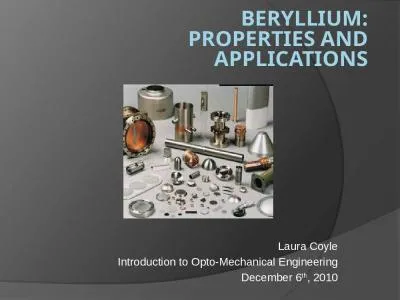

Laura Coyle Introduction to Opto Mechanical Engineering December 6 th 2010 Outline Why use Beryllium Important Properties Manufacturing Process Applications Why Beryllium STIFF yet LIGHTWEIGHT ID: 912484
Download Presentation The PPT/PDF document "Beryllium: Properties and Applications" is the property of its rightful owner. Permission is granted to download and print the materials on this web site for personal, non-commercial use only, and to display it on your personal computer provided you do not modify the materials and that you retain all copyright notices contained in the materials. By downloading content from our website, you accept the terms of this agreement.
Slide1
Beryllium:Properties and Applications
Laura CoyleIntroduction to Opto-Mechanical EngineeringDecember 6th, 2010
Slide2Outline
Why use Beryllium?
Important Properties
Manufacturing Process
Applications
Slide3Why Beryllium?
STIFF, yet LIGHTWEIGHT
DIMENSIONALLY STABLE OVER A WIDE RANGE OF TEMPERATURES
Slide4Important Properties
Density
1.85 g/cm
3
LOW
Young’s Modulus
276-303
GPa
HIGH
Yield Strength
207
MPa
(O-30)
241-296
MPa
(I-200)
Thermal Conductivity
220 W/m K
HIGH
Coefficient of Thermal Expansion
11.5
ppm
/°C
Poisson’s Ratio
0.08
Hardness
80-100 (Rockwell)
Melting Point
1287 °C
HIGH
Slide5More Properties
Resistant to corrosion
High specific stiffness (E/density ~ 160)
Compare to Aluminum (26), Titanium (25)
Similar to Silicon Carbide (140)
High X-ray transparency
Not magnetic
Toxic to humans
Slide6??
Slide7Traditional Die Pressing
Load powder into a mold
Compress using a punch (uniaxial)
Issues:
Non-uniform compaction
Geometrical limitationsCannot achieve 100% theoretical density
Slide8Hot
Isostatic
Pressing
Load powder into a copper mold
Enclose in steel can
Outgas (remove particles that can interfere with bonding)
Compress powder hydrostatically using hot gas
Leach in nitric acid to dissolve mold
Remove mirror
Slide9Vacuum Hot Pressing
Power in mold is compressed from two opposing directions at 1000°C
Compare to HIP
HIP can have up to 50% higher
microyield
strength Lower costLess lead time
Larger blanks – often used to bond
HIP’ed
pieces together
Slide10Powder
HIP is used so make the blank as isotropic as possible
Powder geometry can help:
Can better predict shape of final blank made with spherical powder– less machining required
Spherical powder increases blank isotropy – can use die pressing, vacuum hot pressing
Slide11Polishing
Blanks are cast with near-net shape; usually little machining is required
Polishing can typically achieve surface
roughessness
of 20 angstroms, and surface flatness of
λ/20 peak-valleyBeryllium oxide forms on surface
No coating needed in IR
Coating
for visible/UV is often gold, silver, aluminum
Slide12Cost
Depends on size, complexity, surface finish
Beryllium is an expensive material – powder type can change cost by 50%
Can mix with aluminum to reduce cost
Better to use HIP than machine from scratch
Tolerances on surface can be the driving factor
20 angstroms RMS is fairly standard
10 angstroms RMS is possible with increased cost
Coatings add to cost as well
Quote from AXSYS for
25
mm
bare optic
Beryllium (30 angstroms RMS) - $1334
Aluminum (50 angstroms RMS) - $646
Slide13Application:
Cryo
Telescopes
Good dimensional stability at low temperatures
Lightweight
Used in Spitzer Space Telescope, James Webb Space Telescope
Slide14Application:
Supercolliders
Beryllium is used to make the beam pipes in all 4 experiments for the Large
Hadron
Collider
Dimensionally stable at low temperatures, high vacuum
Non-magnetic – does not interfere with magnets used to steer/focus particle beams
Transparent to high energy particles – does not become radioactive
Slide15References
“Beryllium Products.” Brush Wellman, Inc. <http://www.berylliumproducts.com/>
Delatte
, Michelle, L., “
Ultralight
weight Beryllium mirror development,” Proc. SPIE, Vol. 1753 (1993).Marder, James, “Creation of aspheric beryllium optical surfaces directly in the hot
isostatic
pressing consolidation process,” Proc. SPIE Vol. 1485 (1991).
Parsonage, Thomas. “JWST Beryllium Telescope: Material and Substrate Fabrication,” Proc. SPIE, Vol. 5494, 39 (2004).
Vudler
, V., Richard, P., “Beryllium Mirrors: Refinements Enable New Applications,”
The Photonics Design and Applications Handbook
(2002) <http://www.hardric.com>
Yoder, Paul R.,
Opto
-Mechanical Systems Design
, 3
rd
edition. SPIE Press: Washington, D.C. (2006). pp. 118-121.